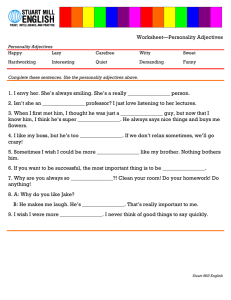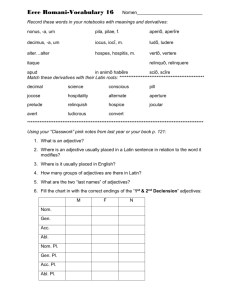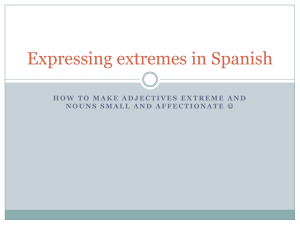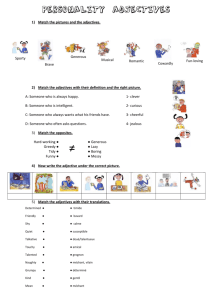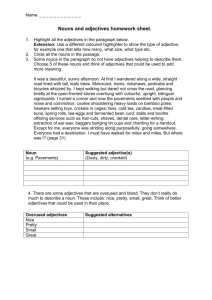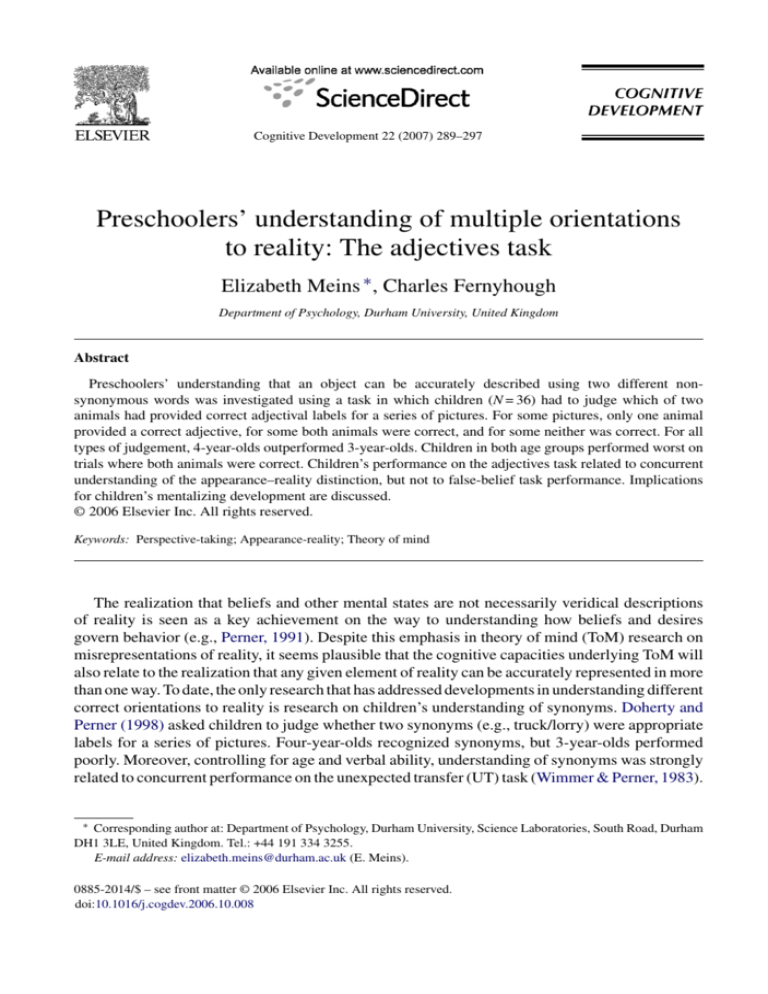
Cognitive Development 22 (2007) 289–297
Preschoolers’ understanding of multiple orientations
to reality: The adjectives task
Elizabeth Meins ∗ , Charles Fernyhough
Department of Psychology, Durham University, United Kingdom
Abstract
Preschoolers’ understanding that an object can be accurately described using two different nonsynonymous words was investigated using a task in which children (N = 36) had to judge which of two
animals had provided correct adjectival labels for a series of pictures. For some pictures, only one animal
provided a correct adjective, for some both animals were correct, and for some neither was correct. For all
types of judgement, 4-year-olds outperformed 3-year-olds. Children in both age groups performed worst on
trials where both animals were correct. Children’s performance on the adjectives task related to concurrent
understanding of the appearance–reality distinction, but not to false-belief task performance. Implications
for children’s mentalizing development are discussed.
© 2006 Elsevier Inc. All rights reserved.
Keywords: Perspective-taking; Appearance-reality; Theory of mind
The realization that beliefs and other mental states are not necessarily veridical descriptions
of reality is seen as a key achievement on the way to understanding how beliefs and desires
govern behavior (e.g., Perner, 1991). Despite this emphasis in theory of mind (ToM) research on
misrepresentations of reality, it seems plausible that the cognitive capacities underlying ToM will
also relate to the realization that any given element of reality can be accurately represented in more
than one way. To date, the only research that has addressed developments in understanding different
correct orientations to reality is research on children’s understanding of synonyms. Doherty and
Perner (1998) asked children to judge whether two synonyms (e.g., truck/lorry) were appropriate
labels for a series of pictures. Four-year-olds recognized synonyms, but 3-year-olds performed
poorly. Moreover, controlling for age and verbal ability, understanding of synonyms was strongly
related to concurrent performance on the unexpected transfer (UT) task (Wimmer & Perner, 1983).
∗ Corresponding author at: Department of Psychology, Durham University, Science Laboratories, South Road, Durham
DH1 3LE, United Kingdom. Tel.: +44 191 334 3255.
E-mail address: elizabeth.meins@durham.ac.uk (E. Meins).
0885-2014/$ – see front matter © 2006 Elsevier Inc. All rights reserved.
doi:10.1016/j.cogdev.2006.10.008
290
E. Meins, C. Fernyhough / Cognitive Development 22 (2007) 289–297
Perner, Stummer, Sprung, and Doherty (2002) replicated this relation between UT performance and understanding of synonyms, and also investigated children’s understanding of other
types of description. For example, children had to judge basic versus superordinate labels (e.g.,
dog/animal), color versus name (e.g., black/dog), or a label for part of the object versus the
name of the whole object. UT performance was only related to children’s understanding of
basic/superordinate categories, and not to the other types of judgement, suggesting that similar executive demands cannot account for the observed relations.
These intriguing findings raise the question of how and when children learn to judge the
applicability of other forms of object label, such as adjectives. Whereas only a limited set of
objects can be indexed by synonyms, multiple adjectives can be appropriately applied to any given
object. Extension of the synonyms paradigm to include adjectives would therefore appear to open
up further possibilities for assessing children’s understanding that the same element of reality
can be taken in different ways. The task reported here involved children judging whether (a) two
different adjectives were both appropriate, (b) only one of the two adjectives was appropriate, or
(c) both adjectives were inappropriate. Investigating relations between these different judgements
allowed us to determine whether children found certain judgements more difficult than others,
and to address potential developmental progression in competence in making these judgements.
Although Doherty and Perner (1998) included trials where only one label was a synonym, these
were not analysed separately, preventing an assessment of the comparative difficulty of these trials
versus those in which both labels were synonyms.
We hypothesised that age would be positively associated with the accuracy of children’s
judgements about whether different adjectives appropriately described a particular object. In
addition, we explored whether young children found judging the appropriateness of some adjective combinations (e.g., both adjectives appropriate) more difficult than others (e.g., only one
adjective appropriate). Given the previously observed relation between performance on the synonym and UT tasks, we also investigated whether children’s performance on the adjectives task
was similarly related to concurrent ToM understanding; specifically, performance on the UT and
appearance–reality (AR; Flavell, Flavell, & Green, 1983) tasks.
1. Method
1.1. Participants
Participants were 36 children (20 girls, 16 boys), consisting of twenty 3-year-olds (M = 43
months; range 37–47 months) and sixteen 4-year-olds (M = 53 months; range 48–59 months),
drawn from two preschools in Sydney, Australia. Two of the children were Chinese-Australian;
the rest of the participants were White. The Chinese-Australian children were both bilingual and
fluent in English.
1.2. Procedure
Participants were tested individually in a quiet area of their preschool. In the first testing
session, children were given the AR task, the UT task, and one block of trials of the adjectives
task, administered in randomized order. In the second session, children received the outstanding
block of trials of the adjectives task, and general verbal ability was assessed using the Peabody
Picture Vocabulary Test III (PPVT-III: Dunn, Dunn, & Dunn, 1997). Children always received
the adjectives task before the PPVT-III.
E. Meins, C. Fernyhough / Cognitive Development 22 (2007) 289–297
291
1.3. Adjectives task
There were two blocks of trials. In each block, children were shown a set of eight simple
color pictures. In one block of trials (both-correct), children had to decide whether only one of
the animals had provided an appropriate label or whether the labels provided by both animals
were appropriate (see Table 1). In the other block (both-incorrect), children had to decide whether
one of the animals had provided an appropriate label or whether both labels were incorrect (see
Table 1). The labels were unambiguously correct or incorrect descriptions of the pictures. For
example, the koala bears were cuddling one another to make the description of “cuddly” more
obviously appropriate.
Children first took part in a pre-test to check that they understood all of the adjectives
used in the trial block. After passing the pre-test, children were introduced to two toy animals (teddy and turtle). Children then participated in two practice trials. For the both-correct
block, children received one practice trial in which only one of the animals provided an appropriate label for the picture (a picture of a chair labeled as “chair” and “table”), and one trial
in which both animals said something appropriate (a picture of a cow labeled as “cow” and
“says ‘moo”’). For the both-incorrect block, the practice trials consisted of one picture where
one of the animals gave an appropriate label (a horse labeled as “horse” and “cat”), and one
where both animals labeled the picture incorrectly (a house labeled as “car” and “truck”). In
these practice trials, the experimenter modeled for the child what the correct response would
be.
Table 1
Test pictures and animals’ corresponding responses for the adjectives task
Picture
Turtle
Teddy
Both-correct block of trials
Both-correct pictures
Snowman
Two koalas cuddling
A pair of open, green scissors
A yellow duckling
Cold
Furry
Sharp
Yellow
White
Cuddly
Green
Small
One-correct pictures
A palm tree
A smiling face drawing
A white and black football
A black ocean liner
Bouncy
Happy
Red
Big
Tall
Hairy
Round
Broken
Both-incorrect block of trials
Both-incorrect pictures
Crocodile
A plain, brown cat
A red car
An open, beige exercise book
Round
Blue
Cuddly
Red
Bouncy
Spotty
Broken
Furry
One-correct pictures
A birthday cake
A blue and white striped mug
Bananas
A red apple
Yummy
Hairy
Yellow
Sleepy
Sharp
Stripy
Fast
Red
292
E. Meins, C. Fernyhough / Cognitive Development 22 (2007) 289–297
The experimenter continued as follows: “Let’s look at some more pictures. Now, sometimes the
animals say silly things, so you have to help me decide who’s right and who’s wrong. Remember,
sometimes only one of the animals says the right thing, and sometimes both of them say the
right/wrong thing about the pictures”. When the child received the second block of the adjectives
task in the second testing session, the experimenter explained that the task had now changed
slightly, highlighting the move to both-correct or both-incorrect responses.
For each picture, the general procedure was as follows. For example, for the picture of the
snowman, the experimenter said, “Here’s a picture of a snowman. Teddy says it’s cold. Turtle
says it’s white”. The memory control questions were then presented in random order: (a) “Who
said it was cold?” (b) “Who said it was white?” If the child had forgotten what either of the animals
said, the labels were repeated and both memory control questions presented for a second time.
None of the children had problems correctly answering the memory control questions. After the
memory control for each picture, the test question was then presented: “Is teddy right, is turtle
right, or are they both right?” The order of presentation of the eight pictures in the both-correct and
both-incorrect sets was fully randomized, and for each child, teddy and turtle were both correct
the same number of times. The order in which the experimenter presented the three responses for
the test question (teddy right, turtle right, both right/wrong) was also randomized. No child was
found simply to parrot the last option given by the experimenter.
Children received 1 point for each correct response, giving an overall score out of 4 for the bothcorrect and both-incorrect pictures, and an overall score out of 8 for the one-correct pictures across
the two tasks. The latter score was divided by 2 in order to make the scores for the both-correct,
one-correct, and both-incorrect pictures fully comparable.
1.4. Theory of mind tasks
1.4.1. Appearance–reality task
Children received a version of Flavell et al.’s (1983) task involving four trials, each using an
object whose appearance was deceptive (e.g., a candle that looked like a cake). The child was
asked two test questions: (a) What is this really and truly? (b) When you look at it with your
eyes right now, does it look like a [candle] or does it look like a [cake]? Children scored 1 point
for each of the four objects if they answered both the reality and appearance questions correctly,
giving a score out of 4.
1.4.2. Unexpected transfer task
Children received two trials of the UT task (Wimmer & Perner, 1983), each using different
toy animals and differently colored boxes. All children passed the memory and reality control
questions. For each trial, children received a score of 1 if they passed, or 0 if they failed, giving
an overall score out of 2.
2. Results
2.1. Descriptive statistics
Four children demonstrated a response bias on the both-correct block, and four different children were response-biased on the both-incorrect block. These children’s data for the block on
which they had shown a bias were excluded from the analyses. These exclusions meant that complete data were available for 32 children on each block of pictures. The one-correct scores for
E. Meins, C. Fernyhough / Cognitive Development 22 (2007) 289–297
293
Table 2
Mean scores for 3- and 4-year olds’ performance on the adjectives, appearance–reality, and unexpected transfer tasks,
and PPVT-III
Variable
Both-correct
One-correct
Both-incorrect
AR task
UT task
PPVT-III
3-Year-olds
4-Year-olds
Both age groups
Mean
S.D.
Range
Mean
S.D.
Range
Mean
S.D.
Range
1.05
1.98
1.55
1.15
.75
99.70
1.39
1.39
1.57
1.27
.97
11.69
0–4
0–4
0–4
0–4
0–2
82–124
2.63
3.28
3.19
2.31
1.31
104.69
1.50
.84
1.42
1.35
1.35
15.19
0–4
0–4
0–4
0–4
0–2
80–131
1.75
2.56
2.28
1.67
1.00
101.92
1.63
1.34
1.70
1.41
.99
13.39
0–4
0–4
0–4
0–4
0–2
80–131
Note: maximum score for both-correct condition, one-correct condition, both-incorrect condition, and appearance–reality
task = 4. Maximum score for unexpected transfer task = 2. Note that 3-year-olds performed significantly worse than 4-yearolds on the appearance–reality task, t(34) = 2.65, p < .025, two-tailed, d = .89, although the performance of the 4-year-olds
was only marginally significantly better than that of the 3-year-olds on the unexpected transfer task, t(34) = 1.75, p = .09,
two-tailed, d = .56.
children who had demonstrated a bias consisted of their scores on the one-correct condition from
the non-biased block.
Table 2 shows descriptive statistics for all tasks. Children’s performance on each of the three
conditions of the adjectives task was normally distributed with indices of skewness and kurtosis
within the acceptable range.
2.2. Performance on the adjectives task
Differences in how the two age groups performed on the three conditions of the adjectives task
were investigated using a 2(age) × 3(condition) ANOVA. There was a main effect of age, F(1,
34) = 14.56, p < .001, η2 = .30, and a main effect of condition, F(2, 68) = 7.27, p < .001, η2 = .18,
but no interaction, F(1, 34) = .35, n.s., η2 = .01. Thus, 3-year-olds performed significantly worse
than 4-year-olds across the both-correct, one-correct, and both-incorrect conditions.
Given that there was no interaction between age and condition, the simple effects analysis
collapsed data across both age groups. Post hoc comparisons using Bonferroni’s adjustment
showed that performance on the both-correct condition was worse than that on the one-correct
condition, t(35) = 3.72, p < .001, two-tailed, and on the both-incorrect condition, t(35) = 2.68,
p < .01, two-tailed. There was no difference between performance on the one-correct and bothincorrect conditions, t(35) = 1.32, n.s.
Table 3 shows the correlation matrix for performance on the different conditions of the adjectives task for both age groups collapsed. As Table 3 shows, highly significant positive correlations
were obtained among both-correct, one-correct, and both-incorrect performance measures. These
correlations remained significant after age and PPVT-III scores had been partialled out (see
Table 4).
2.3. Relations between adjectives task and theory of mind performance
Although, as Table 3 shows, a significant zero-order correlation was seen between children’s
UT performance and scores on the both-correct pictures of the adjectives task, this was no longer
significant once age and PPVT-III scores had been partialled out (see Table 4). As Table 4 shows,
294
E. Meins, C. Fernyhough / Cognitive Development 22 (2007) 289–297
Table 3
Correlations (Pearson’s r) for relations between performance on the adjectives, appearance–reality, and UT tasks, PPVT-III
scores, and age
1. Both-correct
2. One-correct
3. Both-incorrect
4. AR
5. UT
6. PPVT
7. Age
1
2
3
4
5
6
.63††
.75††
.68††
.34*
.35*
.63††
.68††
.68††
.28
.32*
.53†
.67††
.27
.36*
.54††
.43†
.44†
.52††
.46†
.32*
.11
Where both-correct = children’s scores on the both-correct pictures of the adjectives task, one-correct = children’s scores
on the one-correct pictures of the adjectives task, both-incorrect = children’s scores on the both-incorrect pictures of the
adjectives task, AR = children’s scores on the appearance–reality task, UT = children’s scores on the unexpected transfer
task, and PPVT = children’s scores on the Peabody Picture Vocabulary Test III.
Two-tailed probabilities: * p < .05, † p < .01, †† p < .001
the partial correlations for relations between UT performance and the remaining measures of the
adjectives task were not significant. Thus, after controlling for age and verbal ability, there was
no evidence for a correlation between children’s adjectives task performance and their concurrent
UT performance. In contrast, controlling for age and general verbal ability, children who were
better able to judge the appropriateness of the animals’ descriptions for the pictures across all
measures of the adjectives task performed better on the AR task (see Table 4).
2.4. Independent predictors of adjectives task performance
Given the significant associations between the different conditions of the adjectives task, a composite measure for this task was calculated. In addition to the high inter-item positive correlations
shown in Table 3, the composite score had very good internal consistency, Cronbach’s α = .87. The
composite measure scores were used to investigate independent predictors of children’s overall
adjectives task performance using a hierarchical regression analysis. Table 5 shows the structure
and results of this analysis. With all variables entered into the regression equation, children’s concurrent AR task performance was the best predictor of overall performance on the adjectives task.
Table 4
Partial correlations (Pearson’s r) for relations between performance on the adjectives, appearance–reality, and unexpected
transfer tasks, controlling for PPVT-III scores and age
1. Both-correct
2. One-correct
3. Both-incorrect
4. AR
5. UT
1
2
3
4
.38*
.57††
.45**
.03
.49†
.49†
.01
.45**
−.05
.16
Where both-correct = children’s scores on the both-correct pictures of the adjectives task, one-correct = children’s scores
on the one-correct pictures of the adjectives task, both-incorrect = children’s scores on the both-incorrect pictures of the
adjectives task, AR = children’s scores on the appearance–reality task, UT = children’s scores on the unexpected transfer
task.
Two-tailed probabilities: * p < .05, ** p < .01, † p < .005, †† p < .001.
E. Meins, C. Fernyhough / Cognitive Development 22 (2007) 289–297
295
Table 5
Summary of hierarchical regression analysis for variables predicting adjectives task performance
Variable
Step 1
Age
Verbal ability
Step 2
Age
Verbal ability
Appearance–reality
Unexpected transfer
B
S.E. B
β
.43
.10
.09
.04
.60†
.32*
.26
.05
1.58
−.35
.09
.04
.40
.52
.37**
.15
.54†
−.08
Note: R2 = .51 for step 1 (p < .001); R2 = .16 for step 2 (p < .005). * p < .025, ** p < .005, † p < .001.
3. Discussion
Our aim was to extend Doherty and Perner’s (1998) synonyms paradigm to investigate children’s developing understanding of how multiple adjectives can be applied to the same object.
Four-year-olds outperformed 3-year-olds on all aspects of the adjectives task. Children found the
both-correct judgements most difficult, attaining scores that were significantly lower than those on
the one-correct and both-incorrect conditions. These findings suggest that children have a genuine
difficulty in making accurate judgements when two correct labels are simultaneously presented,
rather than simply having problems understanding the concept of “both”, or in judging that the
same response (“right” or “wrong”) is appropriate for both animals.
With regard to associations between adjectives task performance and ToM, controlling for age
and verbal ability, children’s performance on all conditions of the adjectives task was significantly
related to AR task performance. In contrast to these strong associations was the lack of any such
relation with UT scores. A regression analysis showed children’s concurrent AR performance to
be the best predictor of children’s composite adjectives task score.
The findings reported here suggest that, even at ages when they are rapidly acquiring a representational ToM, children have problems in representing two equally appropriate descriptions of a
particular aspect of reality. It is important to highlight that children’s poor performance when both
animals provided a correct adjective could not have arisen because of lack of understanding of
these words, since all children performed perfectly in the pre-test condition. Their difficulty thus
appears to stem from having to judge the correctness of adjectives when two equally appropriate
labels are presented.
How can one account for the findings that (a) 4-year-olds’ performance on all conditions of
the adjectives task was significantly better than that of 3-year-olds; (b) at both ages, judging that
two adjectives were correct labels for an object was more difficult than judgements when only
one adjective was correct or when both were incorrect; and (c) children’s performance on the
adjectives task was strongly associated with concurrent understanding of the appearance–reality
distinction but not false belief? One account that might help explain all of these findings is Gordon
and Olson’s (1998) proposal that ToM understanding is related to, and may even be determined by,
children’s computational capacity for updating information that they are holding in mind. These
authors based their argument on their finding that children’s performance on ToM tasks correlated
strongly with that on complex working memory tasks. Gordon and Olson (1998) suggested that
ToM understanding “is acquired when the child has the computational resources to represent, that
296
E. Meins, C. Fernyhough / Cognitive Development 22 (2007) 289–297
is hold in mind, a previously created representation even when a new representation is created
by a new perceptual situation” (p. 81). Different representations can be mutually accommodated
more easily if the child is able to negate one representation by assigning it to a different subject,
or designating it untrue or not real. The task becomes more cognitively demanding if one cannot
discount representations in this way and must hold them in mind when making future judgements.
This account is consistent with the findings reported here. First, children’s ability to process and
mentally represent information increases with age. Second, given that the computational resources
required to hold information in mind are maximized in the both-correct trials of the adjectives task,
these should be the judgements found most difficult at both ages. Third, the cognitive processing
demands of the adjectives task are more similar to those of the AR task than to those of the UT
task, in that both the former tasks require the simultaneous maintenance of two equally veridical
representations.
Alternatively, it could be argued that the observed relation between performance on the adjectives and AR tasks is due to the fact that the test questions in both tasks are more complex than the
test question in the UT task. That said, the relation between performance on the adjectives and AR
tasks was independent of children’s age and verbal ability, suggesting that language comprehension cannot fully explain the findings. It is also possible that the lower range of scores available
for the UT task (scored out of 2) may have been a factor in the absence of this correlation, a
possibility that may usefully be addressed in future replications.
The present findings suggest that the understanding that different descriptions of an object
can be appropriate at the same time does not predate the emergence of ToM. The finding that
even 4-year-olds have problems in understanding different orientations to reality is somewhat
surprising, given that it is likely that they will have been exposed to countless occasions on which
such differences in perspective are voiced. For example, infant–caregiver interactions typically
involve caregivers describing aspects of the environment in numerous different ways. Moreover,
in symbolic play (seen by some to be a precursor of ToM), participants must understand that
the same object can be different things for different people (Leslie, 1991). Future research might
consider how individual differences in children’s understanding of multiple orientations to reality
relate to their exposure to different views about the same aspect of reality. Continued investigations
into children’s developing capacities in this respect may thus further enrich our understanding of
mentalizing development.
Acknowledgements
This research was funded by a Macquarie University Research Grant awarded to the first
author. The authors are grateful to Judy Ungerer and Max Coltheart for supporting the research
trip on which these data were collected, and to the children, parents, and staff who participated
so enthusiastically in this study.
References
Doherty, M. J., & Perner, J. (1998). Metalinguistic awareness and theory of mind: Just two words for the same thing?
Cognitive Development, 13, 279–305.
Dunn, L. M., Dunn, L. M., & Dunn, D. M. (1997). Peabody picture vocabulary test (3rd ed.). Circle Pines, MN: American
Guidance Service, Inc.
Flavell, J. H., Flavell, E. R., & Green, F. L. (1983). Development of the appearance–reality distinction. Cognitive Psychology, 15, 95–120.
E. Meins, C. Fernyhough / Cognitive Development 22 (2007) 289–297
297
Gordon, A. C. L., & Olson, D. R. (1998). The relation between acquisition of a theory of mind and the capacity to hold
in mind. Journal of Experimental Child Psychology, 68, 70–83.
Leslie, A. M. (1991). The theory of mind impairment in autism: Evidence for a modular mechanism of development? In
A. Whiten (Ed.), Natural theories of mind. Oxford: Blackwell.
Perner, J. (1991). Understanding the representational mind. Cambridge, MA: MIT Press/Bradford.
Perner, J., Stummer, S., Sprung, M., & Doherty, M. (2002). Theory of mind finds its Piagetian perspective: why alternative
naming comes with understanding belief. Cognitive Development, 17, 1451–1472.
Wimmer, H., & Perner, J. (1983). Beliefs about beliefs: Representation and constraining function of wrong beliefs in
young children’s understanding of deception. Cognition, 13, 103–128.


